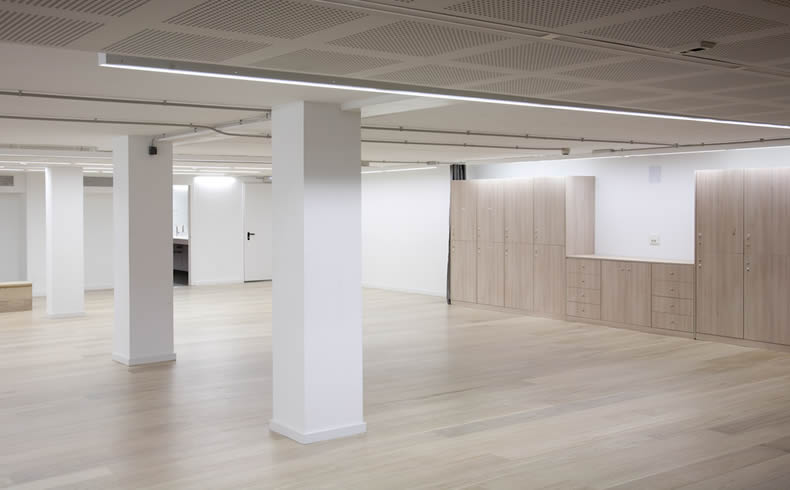History
Una mica d’història
Una mica d’història
The history of the Mercat de les Flors as a municipal theater dates back to 1983, when the then councilor for Culture, Maria Aurèlia Capmany, and the former mayor of Barcelona, Pasqual Maragall, promoted the creation of This scenic area of the city was occupied by the nineteenth-century building of the Palau de l’Agricultura, built following the International Exhibition of 1929 on the Montjuïc mountain.

The history of the Mercat de les Flors as a municipal theatre goes back to 1983, when the then Councillor for Culture, Maria Aurèlia Capmany, and the mayor of Barcelona at that time, Pasqual Maragall, instigated the creation of this city performance space with the renovation of the Palace of Agriculture, built for the 1929 International Expo on the mountain of Montjuïc. After the premiere of the play The Tragedy of Carmen, by Peter Brook, the Mercat launched an irresistible programme of international shows and artists and, naturally, Catalan ones too. In the old warehouse of the Palace of Agriculture, Brook had found an ideal performance space for his play and managed to transmit his enthusiasm to the city’s cultural authorities. This space and the rest of the Mercat de les Flors was remodelled and opened as a municipal theatre in 1985 with the premiere of Mahabarata, once again with Peter Brook directing.
The great dome, twelve metres in diameter, which covers the Mercat entrance hall, is the work of the Majorcan artist Miquel Barceló. In 1990, the City Council began the enlargement of the Mercat de les Flors, adding a new venue, the so-called B Space (Espai B), adjacent to the main building of the Mercat, and which was later named the Sala Ovidi Montllor. This space was eventually demolished to make way for the construction of the Institut del Teatre, including a new performance space on its premises, with the same name, which currently shares the programming with the Mercat. Therefore, the Mercat has four venues with uninterrupted programming: the Sala Maria Aurèlia Capmany, the Sala Ovidi Montllor, the Sala Sebastià Gasch, which hosts small-scale activities, and the Sala Pina Bausch, a multipurpose auditorium also for small-scale activities.
The theatre, even in its beginnings, aimed to set an example in all types of creative expression: theatre, dance, music, performances, media art. Directors such as the aforementioned Peter Brook, Luca Ronconi, Peter Stein, Patrice Chéreau, Carlos Marqueríe, Robert Lepage, Tadeusz Kantor, Pina Bausch, Anatoli Vassiliev, Mario Gas, Calixto Bieito and Roger Bernat; national companies and figures such as La Fura dels Baus, Comediants, Els Joglars, La Cubana, Sèmola Teatre, Sol Picó, Mal Pelo, Àngels Margarit / Cia Mudances, La Carnicería Teatro and Teatro de la Abadía; international ones such as Phillipe Genty, Wim Vandekeybus, La La La Human Steps and Rosas; festivals such as ArtFutura, Festival Àsia and Primavera Sound; cinema with the presence of directors such as Fernando Trueba, Fernando León, Joaquim Oristrell and Jaume Balagueró; or music with La Paquera de Jerez, Carlos Santos, Georges Moustaki and many, many others, have made the Mercat de les Flors a touchstone for the performing arts and contemporary creativity in Catalonia. Since it opened, the Mercat has been directed by Joan M. Gual (two terms), Elena Posa, Andreu Morte (also on two occasions) Francesc Casadesus (from 2005 until 2016) and Àngels Margarit (2017-2025). The current director is María José Cifuentes.
Since Mercat de les Flors established as a Dancehouse in 2006 -under Francesc Casadesús’s direction-, the programme has focused on contemporary dance and arts of moviment and hosted companyies and coreographers such as Merce Cunningham, The Forsyhte Company, Peeping Tom, Les Ballets C de la B / Alain Platel, Akram Khan, Benoît Lachambre and Louise Lecavalier, Raimund Hoghe, Carolyn Carlson, DV8, Dave St. Pierre, Akram Khan, Thomas Hauert, Hofesh Schechter, Australian Dance, Sankai Juku, Jérôme Bel, Kidd Pivot with Electric Company Theatre, Sidi Larbi Chekaoui… and the spanish creators as Rafael Bonachela, Israel Galván, marcos Moreau / La Veronal, Blanca Li… The programme also includes a touch of Circus, with names like Baró d’Evel Cirk Cie, Les 7 Doigts de la main or Les Colpolteurs or Cirque Ici- Johann Le Guillerm.
The Mercat de les Flors is part of the amenities that make up the so-called Ciutat del Teatre (City of Theatre), which consists of three theatre venues in the surroundings of the Plaça Margarita Xirgu: the Mercat itself, Teatre Lliure and Institut del Teatre.



